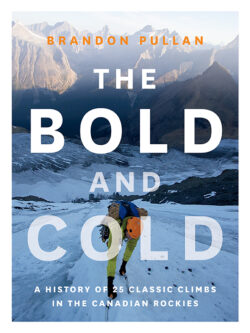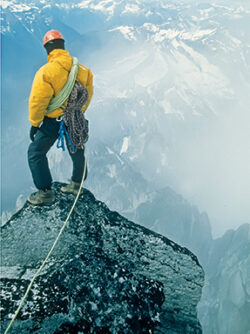#58 Off the danger scale
The Bold and Cold: A History of 25 Classic Climbs in the Canadian Rockies
by Brandon Pullan
Victoria: Rocky Mountain Books, 2016
$45.00 / 9781771601153
Reviewed by Rod Szasz
First published Dec. 4, 2016
*
In The Bold and Cold, Brandon Pullan tells the story of the classic climbs in the Canadian Rockies in the “Golden Age” of climbing, 1960-1990, when many of the peaks in B.C. and Alberta were first summited.
Reviewer Rod Szasz, himself a mountaineer, praises the steel cold mentality of the iconoclastic and unknown climbers who led the world in their technical ascents on snow, ice, and rock — Ed.
*
 Images of a Golden Age of Alpine Mountaineering evoke thoughts of Albert Mummery, Edward Whymper, and George Mallory, earlier and well known representatives of the mountaineering spirit in the Alps and Himalayas, but Brandon Pullan’s The Bold and Cold fills a void in the history of the personalities and pioneered routes during the “Golden Age” (1960-1990) of Alpine Mountaineering in the Canadian Rockies.
Images of a Golden Age of Alpine Mountaineering evoke thoughts of Albert Mummery, Edward Whymper, and George Mallory, earlier and well known representatives of the mountaineering spirit in the Alps and Himalayas, but Brandon Pullan’s The Bold and Cold fills a void in the history of the personalities and pioneered routes during the “Golden Age” (1960-1990) of Alpine Mountaineering in the Canadian Rockies.
While the vastness of Canada, sparse population, and hard-to-access peaks mean that much of the truly innovative mountaineering enterprises have occurred in our recent history, they had much in common with the Golden Age of their predecessors.
This is not an average story of “dirt-bag” climbers pirate-camping in vans, selling valuables to get enough to attempt the next climb, lounging in the sun and eating junk food before the next climb. This is a far cry from Yosemite, where climbers could count on relatively good weather and solid rock, and scan their routes from the relative comfort of the valley. The B.C. and Alberta Rockies are much less forgiving. They still contain many unclimbed peaks and even more unclimbed routes.

In the Canadian Rockies, the climbing process in the Golden Age required maximum commitment: sheer remoteness, limited access, and lack of climbing data meant that climbers had to figure out access routes and often pioneer whole new routes to the top. Sometimes the tales of earlier parties scared off others, leaving routes with a single or uncompleted ascent.
Cold even on the warmest days, the Rockies are no fun when you are tens of kilometres up an unexplored valley in mixed conditions: inside an icy couloir with weather deteriorating, with no cell phones, no emergency beacons, little or no information on the intended route or on possible descents. The edge doesn’t come much sharper than this.
In Bold and Cold, Brandon Pullan portrays this reality and the steel cold mentality that arose to deal with it. He provides a sustained look at the iconoclastic and unknown climbers who led the world in technical ascents on ice, rock, and on the mixed climb — that most peculiar Canadian feature consisting of remorseless ice, snow, and rock.
On one level The Bold and the Cold is a homage to Dave Cheesmond and Urs Kallen, the Canadian and Swiss mountaineers who climbed some of the 25 climbs described in this book. It is also a history of the classic, fearful, and deadly climbs at the core of the Canadian Rockies, giving it points of similarity with climbing classics such as Maurice Hertzog’s Annapurna (1952) and Heinrich Harrar’s The White Spider (1959). Pullan’s account of the climbs of the Golden Age includes accounts by Cheesmond and Kallen, their initial explorations, and subsequent route variations. The challenges they faced went right off the danger scale.

Pullan provides interwoven stories from journals and trip reports to enhance his accounts. Andromeda Strain, for example, on Mt. Andromeda — in the Columbia Icefields next to Mount Athabasca — is a long ice runnel with steady and rather predictable climbing above and below. But the rock band in the middle yields a different climb for every team to visit the mountain: one party will have a strange, trouser-filling, off-stance-teetering-on-crampon-points-with-no-protection adventure; another party will have the angst of being hit by tonnes of snow before having a chance to look up, with the potential for a sudden sort of airborne death. A move of ten metres on a thin rib on North Howser Tower can yield a totally different climb on the same route.
Pullan’s climbs in the Canadian Rockies are as hoary as the people who climb them. Preparation includes an awareness of varying rock quality, an understanding of ice (which might or might not be in a condition to climb), and an expectation of snow, ice, and rock all on the same route.

Then there is that particularly dark niggle of Canadian adventure, the dry-tool climb. This sport was spawned when some climbers on an ice wall suddenly noticed there was no more ice, but the route continued in front of them. What to do? The solution in the past was to “bail the route” (leave), or try another line. At some point, climbers discovered, with patience and slow and determined placement, that upward momentum could be maintained. This determination pushed the technical limits of climbing up a notch. Tools and people got better. The sheer psychological tension of balancing front-points and ice axes on nubs and cracks the size of pencil heads drove the sport of Alpine climbing to a new level. Scottish Ice suddenly had a full-grown Canadian dry-tool cousin.
Bold and Cold chronicles this expansion in technical style that was sheer in its physicality but largely ignored by traditional climbing narratives: for example, 700 metres of extreme rock climbing followed by another 700 metres of ice make Mt. Geikie (in B.C.’s Mount Robson Provincial Park) a particularly chilling challenge, as does the Japan route on Mt. Alberta (in Jasper National Park), which is a sheer pile of rotten rock. Not many have heard of these or a host of other remote peaks featured here, but a close look at the photos of their sheer faces will leave no doubt that the Canadian Rockies represent some of the last frontiers of climbing.

The book is, first and foremost, adventure: adventure of the unknown, whether on the rock of C.M.C. Wall on Mt. Yamnuska, near Canmore, or the crappy uncertainty of the rock and lack of a route on Mt. Alberta. Bold and Cold displays the initial forays – the long, time-consuming route analysis employing techniques and styles eclipsed by those who followed. But progression is not infinite. Many routes were done in earlier days with equipment and styles we may find rather quaint, but some early routes were so technical and dangerous that they have never been repeated.
This is also, interestingly, a guidebook with route instructions. I did wonder how useful the limited climbing notes were — but it did not really matter. The whole book is an endless series of adventures: enough to keep an interested reader enthralled for a good while.
Most importantly, Bold and Cold reminds us that adventure still exists in the twenty-first century. It lives in the shaded and cold nether reaches of a couloir in the Canadian Rockies.
Pullan presents larger than life personalities with little or no pretension of fame. Their names unknown outside a very select circle, most of them continue to climb while shunning the spotlight. The Bold and Cold may, or may not, make them better known, but it will provide a new appreciation of the personalities and challenges of climbing in the Canadian Rockies.
Cold pathos is ingrained on many routes. Those who have encountered the carnage of Bad Rockies Weather or rotten luck with loose rocks will echo Pullan’s stark warnings. Having survived the Rockies, Dave Cheesmond has, since 1987, sat in climbing arrest position, freeze-blasted to the ridge wall of an Alaska peak. One could view his motionless body as a warning to all other seekers or as a monument to life – as an intrepid beacon for those willing to attempt the new, to challenge the bold and cold.
*

Rod Szasz is an inventor and entrepreneur with a love for adventure and climbing. Educated at Malaspina University-College (now Vancouver Island University) and the London School of Economics, he has spent almost all his adult life outside Canada. He has climbed extensively in Asia including some of the premiere ice routes in Japan and early rock routes in mainland China, including the original Todd Skinner Routes on Moon Mountain. He now lives with his family on Vancouver Island, where he was born. There he is engaged in raising a family and summiting some of the last unclimbed peaks on Vancouver Island.
*
The Ormsby Review. More Books. More Reviews. More Often.
Publisher and Editor: Richard Mackie
The Ormsby Review is a journal service for in-depth coverage of B.C. books and authors. The Advisory Board consists of Jean Barman, Wade Davis, Robin Fisher, Cole Harris, Hugh Johnston, Patricia Roy, David Stouck, Maria Tippett, and Graeme Wynn. Scholarly Patron: SFU Graduate Liberal Studies. Honorary Patron: Yosef Wosk. Provincial Government Patron since September 2018: Creative BC
“Only connect.” – E.M. Forster
One comment on “#58 Off the danger scale”
Comments are closed.